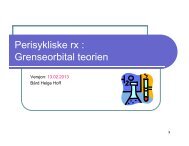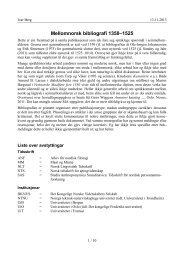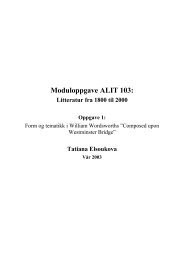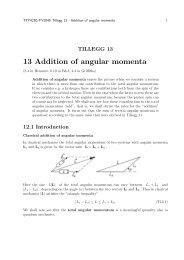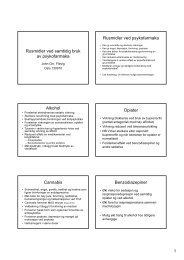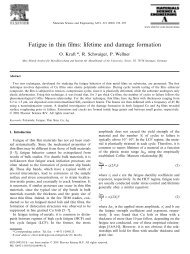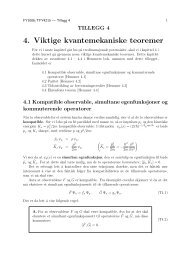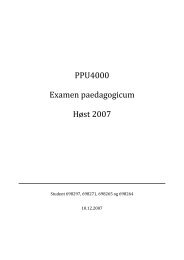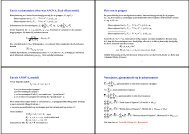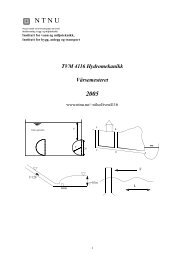On barrier analysis - NTNU
On barrier analysis - NTNU
On barrier analysis - NTNU
You also want an ePaper? Increase the reach of your titles
YUMPU automatically turns print PDFs into web optimized ePapers that Google loves.
1<br />
Barriers and <strong>barrier</strong><br />
classification<br />
Mary Ann Lundteigen<br />
(mary.a.lundteigen@ntnu.no)<br />
Updated Sept 2011<br />
RAMS
2<br />
The role of <strong>barrier</strong>s: Haddon<br />
Hazard<br />
(energy<br />
source) or<br />
threat<br />
Barrier<br />
“Energy model”<br />
Victim<br />
Haddons 10 strategies to risk reduction<br />
Avoid the release of hazards:<br />
1. Prevent the (creation of) hazard or threat<br />
2. Reduce the amount of hazard or threat<br />
3. Prevent the release of hazard or threat<br />
4. Modify the rate of release from its source<br />
Reduce the severity of damage:<br />
5. Separate in time or space the released hazard or<br />
threat<br />
6. Separate with physical means of physical<br />
protection<br />
7. Modify the relevant properties of the hazard or<br />
threat<br />
8. Make the victim more resistant to the damage<br />
Stabilize and restore:<br />
9. Reduce the further development of damage (in<br />
time and amount)<br />
10. Stabilize, repair, and rehabilitate from damage
3<br />
Terms<br />
Hazard:<br />
Potential source of<br />
harm (ISO 14121)<br />
Threat:<br />
An expression of<br />
intention to inflict evil,<br />
injury or damage<br />
(Garrick et al, 2004)<br />
Hazardous event:<br />
Event confined to the first<br />
significant release of a<br />
hazard that will result in<br />
harmful exposure if not<br />
controlled (Johansen, I.L.,<br />
2010)<br />
See http://www.ntnu.no/ross/reports/johansen‐risk‐foundation.pdf
4<br />
Terms<br />
Risk (II):<br />
The effect of<br />
uncertainty on<br />
objectives (ISO 31000)<br />
Risk (I):<br />
By answering the following<br />
questions (Kaplan & Garrick,<br />
1981):<br />
1. What can go wrong?<br />
2. How likely is it?<br />
3. If it does happen, what are<br />
the consequences?<br />
Effect: A deviation (positive or negative)<br />
Objectives: Financial, health, safety,<br />
environment<br />
aspects of products, systems, organizations,…<br />
Uncertainty: Lack of knowledge<br />
Illustrations from http://www.ntnu.no/ross/reports/johansen‐risk‐foundation.pdf
5<br />
Terms<br />
(Safety) <strong>barrier</strong>:<br />
Safety <strong>barrier</strong>s are physical<br />
and/or non‐physical means<br />
planned to prevent, control, or<br />
mitigate undesired events or<br />
accidents (Sklet, 2006)<br />
Illustrations from http://www.ntnu.no/ross/reports/johansen‐risk‐foundation.pdf
6<br />
The role of <strong>barrier</strong>s: Swizz cheese<br />
Barriers may have weaknesses, by Reason referred to as active failures and latent<br />
conditions<br />
Hazard<br />
(energy<br />
source) or<br />
threat<br />
Barriers<br />
Victim<br />
Source: J. Reason (1997)
7<br />
The role of <strong>barrier</strong>s<br />
Frequency<br />
reducing <strong>barrier</strong>s<br />
Consequence<br />
reducing <strong>barrier</strong>s<br />
Hazardous<br />
event<br />
Triggering<br />
event<br />
“Bowtie model”<br />
End consequences<br />
/accidents
8<br />
Vulnerability analyses<br />
Emergency preparedness<br />
analyses<br />
Risk analyses<br />
Frequency<br />
reducing <strong>barrier</strong>s<br />
Consequence<br />
reducing <strong>barrier</strong>s<br />
Hazardous<br />
event<br />
Triggering<br />
event<br />
“Bowtie model”<br />
End consequences<br />
/accidents<br />
Haddon 1-4 Haddon 5-8<br />
Haddon 9-10
9<br />
Reliability analyses<br />
Hazardous<br />
event<br />
“Bowtie model”<br />
End consequences<br />
/accidents
10<br />
Fault tree <strong>analysis</strong><br />
Event tree <strong>analysis</strong><br />
Reliability analyses<br />
Hazardous<br />
event<br />
“Bowtie model”<br />
End consequences<br />
/accidents
11<br />
Classification of <strong>barrier</strong>s<br />
Safety <strong>barrier</strong>: Physical and/or non‐physical means planned to<br />
prevent, control, or mitigate undesired events or accidents<br />
(Sklet, 2006)<br />
What<br />
How<br />
Barrier function: A function planned to prevent, control, or mitigate<br />
undesired events or accidents. (Sklet, 2006)<br />
Barrier system: A system that has been designed and implemented<br />
to perform one or more <strong>barrier</strong> functions (Sklet, 2006)
12<br />
Classification of <strong>barrier</strong>s<br />
Barrier function<br />
What to do<br />
Barrier system<br />
How to do it<br />
Always available<br />
Passive<br />
Active<br />
Available on<br />
demand<br />
Physical Human/operational Technical Human/operational<br />
Other technology<br />
systems*<br />
Safety instrumented<br />
systems<br />
Other technology<br />
systems<br />
Based on Sklet (2006)
13<br />
Performance of <strong>barrier</strong>s<br />
Criteria Definition Example (SIS)<br />
Functionality /<br />
effectiveness<br />
Reliability/ availability<br />
Ability to perform a specified function under<br />
given technical, environmental, and operational<br />
conditions<br />
The ability to perform a function with an actual<br />
functionality and response time when needed,<br />
or on demand<br />
The SIS shall detect certain<br />
unwanted events and take<br />
specified actions (Effectiveness in<br />
%)<br />
Safety integrity level (SIL) or<br />
Probability of failure on demand<br />
(PFD)<br />
Response time<br />
Robustness<br />
Triggering event or<br />
condition<br />
The time from a deviation occurs that should<br />
have activated a safety <strong>barrier</strong>, to the fulfillment<br />
of the specified <strong>barrier</strong> function<br />
The ability to resist given accident loads and<br />
function as specified during accident sequence<br />
The event or condition that triggers the<br />
activation of the <strong>barrier</strong><br />
Valve closure time<br />
Hardware fault tolerance<br />
Trip signal from sensors<br />
Based on Sklet (2006)
14<br />
Example:<br />
Taken from:<br />
http://www.pennenergy.com/index/petroleum/display/297003/article<br />
s/offshore/volume-67/issue-6/subsea/hipps-protects-subseaproduction-in-hp-ht-conditions.html
15<br />
The closing time<br />
for the HIPPS valve<br />
as a function of operating<br />
pressure<br />
(We assume that it has<br />
been verified that 12 seconds<br />
closing time at 280 bar is<br />
adequate)<br />
RAMS
16<br />
Question for group discussions:<br />
• Identify performance criteria<br />
for the HIPPS system<br />
RAMS



